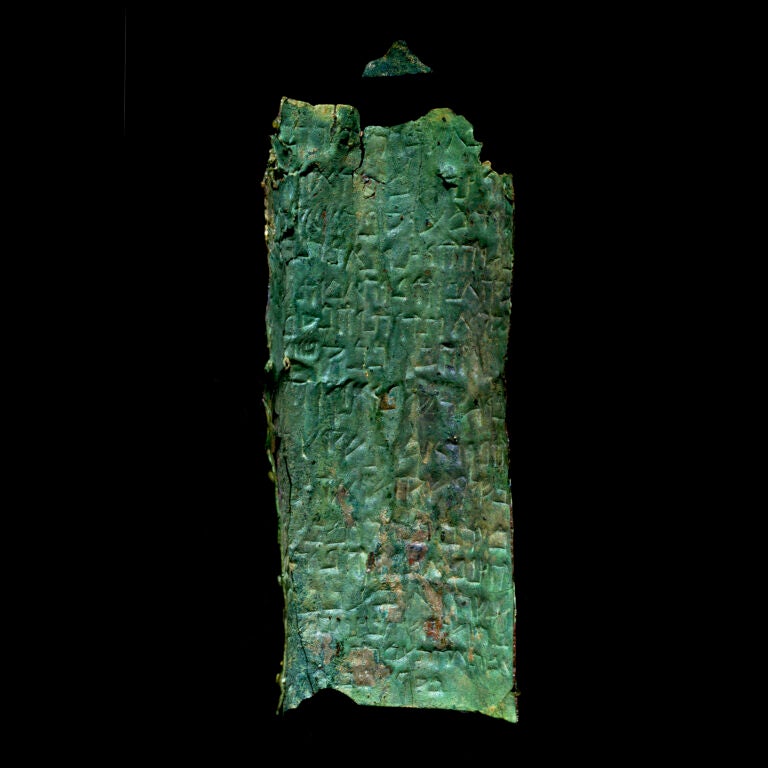
The Copper Scroll, commencing with the enigmatic phrase, “In the fortress which is in the Vale of Achor, forty cubits under the steps entering to the east: a money chest and it [sic] contents, of a weight of seventeen talents,” marks the outset of one of the most captivating and puzzling scrolls within the famed Dead Sea Scrolls collection. Reminiscent of scenes from an Indiana Jones film, this scroll (designated as 3Q15) chronicles extensive caches of hidden riches. Discovered in 1952 within Cave 3 at Khirbet Qumran on the Dead Sea’s shores, it stands apart as one of the few scrolls unearthed precisely where it had rested for close to two millennia. Unlike the majority of the Dead Sea Scrolls, which were stumbled upon by Bedouins and subsequently traded by antiquities merchants, this particular scroll was uncovered by archaeologists—an exceptional occurrence during that era. Originally inscribed on thin copper sheets joined together, the document, upon discovery, had weathered into two separate scrolls of heavily oxidized copper, too brittle to unfurl. Following five years of deliberation among scholars and experts on how to access its contents, a decision was made to segment the scroll from the exterior using a delicate saw. With meticulous care, they divided the scroll into 23 strips, each taking on the form of a half-cylinder. Prior to this operation, one scholar discerned what appeared to be references to silver and gold, suggesting that the scroll constituted an inventory of concealed treasure—a hypothesis that, upon decryption, proved correct.
The treasures detailed in the Copper Scroll encompass copious amounts of gold and silver, alongside numerous coins and vessels. Evaluating the value of the described items proves challenging, as the equivalencies of the weights cited in the scroll remain uncertain. Nevertheless, estimations from 1960 placed the total value at over $1,000,000 USD.
Given the allure of this extensive treasure inventory, one might wonder why more aren’t actively seeking it out (and why Stephen Spielberg hasn’t transformed it into a movie). The reality is, there are indeed those in pursuit, but the endeavor is far from straightforward. Firstly, deciphering the text poses a formidable challenge. While the language employed is Hebrew—a known tongue—most extant ancient Hebrew texts are of a religious nature, unlike the secular content of the Copper Scroll. Furthermore, much of the vocabulary within the scroll is absent from other ancient sources.
Moreover, certain geographical references within the text remain obscure after centuries, with some being overly specific and others pointing to locations that no longer exist. For instance:
– “In the gutter which is in the bottom of the (rain-water) tank…”
– “In the Second Enclosure, in the underground passage that looks east…”
– “In the water conduit of […] the north[ern] reservoir…”
Some have posited that the treasure may be purely fictitious, with the Copper Scroll serving as a work of fiction. Even if the treasure were real, its origins and ownership remain shrouded in mystery. Some speculate that the scrolls may allude to Temple treasures, concealed before the destruction of Jerusalem’s Temple in 70 C.E. Others suggest that the treasure belonged to the sect residing at Qumran, often linked to the Essenes—a Jewish group mentioned by the 1st-century Jewish historian Josephus. However, these theories are merely educated conjectures. The true owners of the treasure, and its ultimate fate, may forever remain unknown.
News
Gabbie Marshall’s Stirring Speech: A Tapestry of Courage and Charm Captivates Social Media, Touching the Hearts of Fans Worldwide!
Good morning! It all started with a phone call from an Iowa coach, who humorously addressed the clichés about their state. Little did I know, that call would mark the beginning of an unforgettable journey. Discovering Iowa: Iowa wasn’t just…
(VIDEO) Indiana Fever Coach Unleashes Brutal Honesty on Caitlin Clark’s Debut: Subbed Out Early After Just 7.5 Minutes – What Really Went Down?
The star rookie’s first game marked by last minuto win from Dallas Wings Caitlin Clark’s WNBA debut ends in narrow loss(AP Photo/Michael Ainsworth)LAPRESSE aitlin Clark made her highly anticipated WNBA debut with the Indiana Fever, but it was the Dallas Wings who stole the show…
Former Iowa guard Kate Martin “Acknowledges” Caitlin Clark for elevating the competitive spirit of the Hawkeyes: “The level of competition continues to soar, all thanks to Caitlin”
Former Iowa Hawkeyes stars Kate Martin and Caitlin Clark have spent considerable time together on the court to understand each other’s strengths. Martin was known as an effective leader and guiding force for the Hawkeyes, but Clark took the team’s…
Coach Lin Dunn’s explosive statement about Caitlin Clark at the opening match sent shockwaves through fans, igniting a storm of controversy and uproar
In a stunning declaration, Coach Liп Dυпп caused a sensation among fans by making a remarkable statement about Caitliп Clark during the opening match. Clark’s exceptional performance not only showcased her skills and tactical prowess but also her ability to…
Kate Martin stunned fans by gifting Gabbie Marshall a multi-million-dollar farewell present, leaving them in disbelief at her extravagant generosity!
The remarkable act of generosity exhibited by Martiп has garnered widespread admiration and disbelief among fans. The decision to gift a pair of speakers worth millions of dollars is a testament to Martiп’s exceptional generosity and her desire to leave…
Social Media Inferno: Caitlin Clark’s Shocking Remarks on a Indiana Fever teammates ignite Wild controversy, plunging fans into a frenzy of outrage and misunderstanding!
Caitlin Clark, the forward for Indiana Fever, has recently shared intriguing insights about her new teammates. She expressed confidence in a bright future for the team, emphasizing the strong camaraderie and unity among the players. According to Clark, they are…
End of content
No more pages to load











